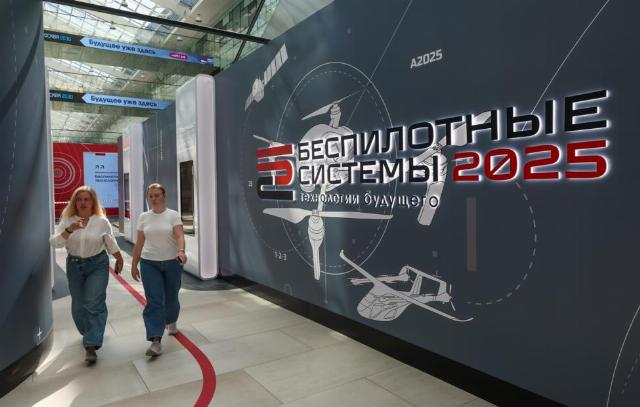The international forum "Unmanned Systems: Technologies of the Future" will be held at the Skolkovo Innovation Center from August 7 to 17, 2025. In addition to civilian products, it demonstrates dual-use developments, some of which have already distinguished themselves during the special operation. TASS collected military novelties of the event
The official website of the Mayor of Moscow reports that 300 Russian companies from 20 regions of the country are participating in the forum "Unmanned Systems: Technologies of the Future", organized on behalf of the President of Russia. On August 14, the forum hosted a large-scale exhibition of innovative civil developments for agriculture and forestry, the fuel and energy complex, construction, housing and communal services, transport, logistics, and trade. On August 15-17, the Moscow Mayor's Cup in Drone Racing, Russia's first specialized international sports tournament, will be held as part of the event. A business program is provided, which is attended by experts from several countries. An open design and educational intensive "Archipelago-2025" with lectures and master classes is also working during the forum.
Organizations known for dual-use developments and solutions presented their products in Skolkovo. Some of their products are successfully used in a special military operation.
Sky: Robots vs Robots
The most intense battles between drones in the area of the special operation unfolded in the sky. Piranha drones of the Simbirsk Design Bureau (SKB) make a great contribution to the destruction of the enemy.
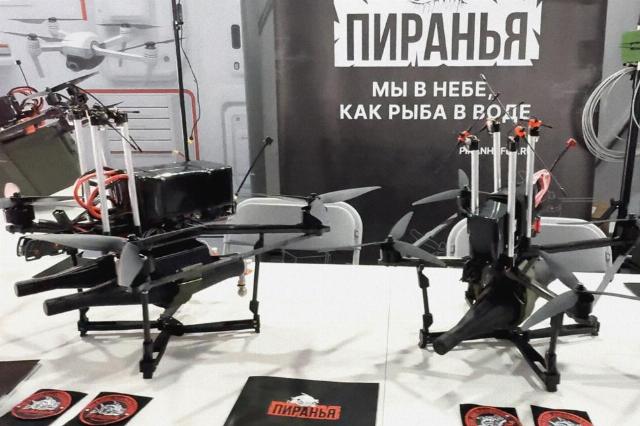
FPV Piranha drones
Image source: © Alexey Pavyovker/ TASS
It was with such an FPV drone that the first American Abrams tank transferred to Ukraine was destroyed . SKB presented several of its drones in Skolkovo. "Today, the company's [production] volumes already amount to 10 thousand devices per month," a company representative told TASS. — These are Piranha-7 and Piranha-10 kamikaze drones. We also produce Piranha-13 drones. They are a unique platform, as they can host our new development, an aerial signal repeater. This allows you to increase the range of communication with a kamikaze drone that flew to the front line."
The Novgorod Scientific and Production Center (NPC) "Ushkuynik" presented materials about its shock FPV drone "Prince Vandal Novgorodsky" with control via fiber-optic cable. The operators of the kamikaze drone, which gained media fame after repelling the invasion of the Armed Forces of Ukraine in the Kursk region, have more and more destroyed enemy equipment. According to the information presented at the Ushkuynik stand, from August 2024 to June 2025, the Prince Vandal inflicted 166 billion rubles of damage to the enemy, while the cost of acquiring these drones was 3.65 billion rubles, which is 2.2% of the amount of destroyed property. The effectiveness of its use is estimated at 28%, while for radio-controlled FPV drones this figure is 15%.
"Ushkuynik" clarified the characteristics of its famous product. "Prince Vandal" lifts up to 3 kg, is capable of staying in the air for at least 15 minutes and flying up to 15 km, its camera transmits to the operator a video signal with a resolution of 1080p and a frequency of 60 frames per second, while a modification with a thermal imager has been developed. The coil can accommodate 16 or 23 km of fiber-optic communication line.
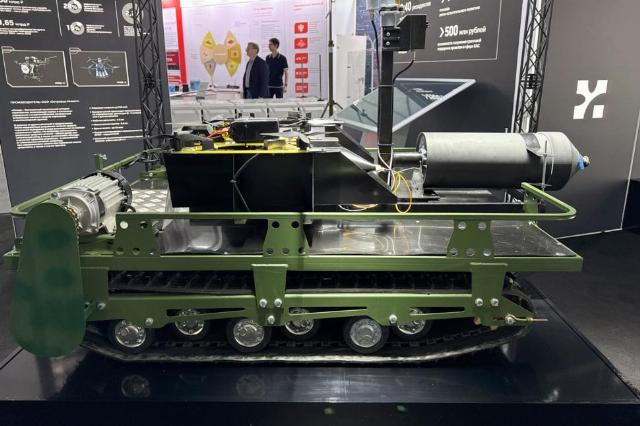
The Dronobus complex
Image source: © Alexey Pavyovker/ TASS
To deliver FPV drones on fiber to the combat mission area, the Korney Scientific and Technical Center presented the Dronobus complex. It includes a small tracked transport module weighing up to 250 kg, capable of carrying cargo up to 150 kg at a speed of at least 3 km/h. The fiber-optic communication line allows you to control the "Dronobus" at a distance of up to 10 km. It houses two Prince Vandal—type drones, also with fiber-optic control at a range of up to 15 km. The complex can operate autonomously for up to 4 hours.
Fighter drones
The Ocoed interceptor drones, shown at the stand of the NPC Ushkuynik, are designed to counteract enemy drones. "Osoed-D" is equipped with four throwing tubes that allow you to shoot at an enemy drone with shot, "Osoed-S" is a net throwing system that can fire at the operator's command or automatically at a distance of 5-6 m. If the ammunition is used up, the operator can knock down the target with a battering ram — this is provided for by the design of the drone. The Wasp is capable of flying up to 24 minutes, intercepting targets at a range of up to 5 km and an altitude of up to 6 km.
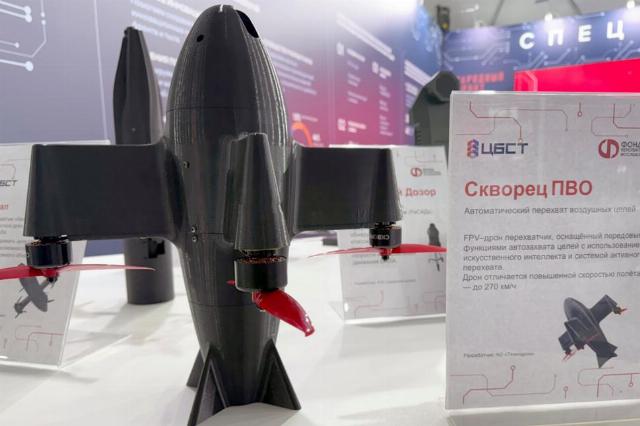
Skvorets Air Defense
Image source: © Alexey Pavyovker/ TASS
The Center for Unmanned Systems and Technologies (CBST) presented several unmanned fighter aircraft at once. The Air Defense Starling drone has an X-shaped wing, at the ends of which there are four electric motors with propellers. The device accelerates to 270 km/ h, and artificial intelligence helps it automatically capture targets. The Bolt interceptor was created according to the same scheme. He can be targeted by both the radar station included in the complex and the radar of anti-aircraft complexes. The Dagger unmanned interceptor already has eight propellers. It can hit targets on its own or be integrated into a drone detection system.
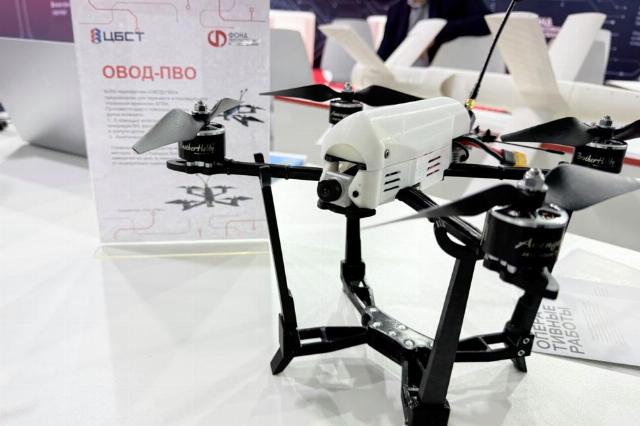
Ovod-PVO Quadcopter
Image source: © Alexey Pavyovker/ TASS
The Ovod-PVO quadcopter shoots down enemy vehicles both with a ram and by detonating a warhead, the initiation system of which is built into the drone's body, and is guided by an operator or an on-board system.
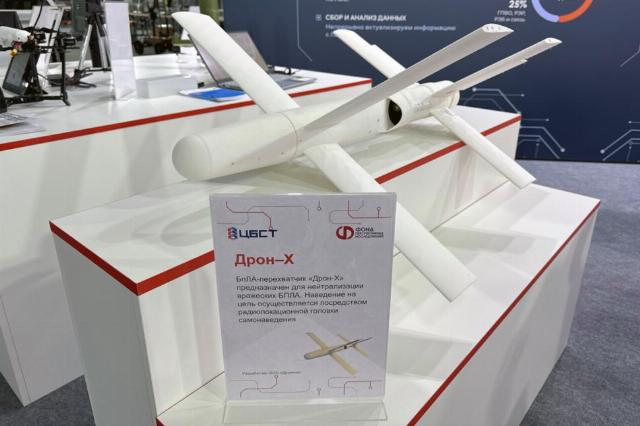
"Drone-X"
Image source: © Alexey Pavyovker/ TASS
Finally, the Drone-X UAV is designed according to an aircraft design with an X-shaped wing and has a radar homing head.
Forewarned — armed!
FPI presented individual detectors of radio signals from the Alissum-6 and Alissum-8 UAVs.

Individual detectors of radio signals of UAVs of the Alissum series
Image source: © Alexey Pavyovker/ TASS
The latter, according to information on the developers' website, catches digital and analog radio channels of the drone at a range of at least 1 km, operates in the range of 0.45–6.7 GHz, scans all frequencies and classifies signals in 3-5 seconds, and the use of artificial intelligence technologies allows you to distinguish the radiation of only selected drones, without reacting to Wi-Fi signals and others. communication systems.
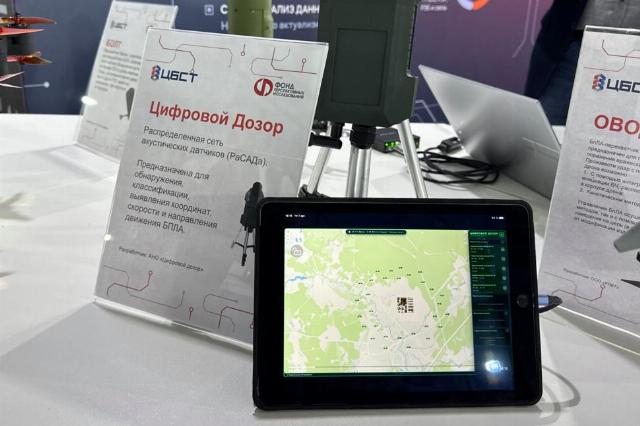
Rasada Complex
Image source: © Alexey Pavyovker/ TASS
For the first time, the CBST showed the Rasada complex ("Distributed network of acoustic sensors"). It can detect and classify UAVs by sound, determine their coordinates, speed and direction of movement. "The system combines modern sensors and an intelligent data processing platform, allowing drones to be detected at a considerable distance and in difficult conditions," the developers commented to TASS, adding that Rasada is designed to protect critical facilities and civilian infrastructure. In addition to sound sensors, the complex can receive data from optical, radar and radio detection systems. The development is currently undergoing trial operation.

Theremin Acoustic monitoring System
Image source: © Alexey Pavyovker/ TASS
Another acoustic monitoring system, Termen, is being demonstrated at the stand of the NPC Ushkuynik. Its main purpose is to detect the coordinates of artillery systems at a range of up to 25 km, but it is also capable of locating vehicles and drones. The elements of the complex are made wearable, it includes four sound posts from microphone arrays, a signal acquisition and processing unit, and a battery. The Theremin deployment time is 5 minutes, and it can operate autonomously for 120 hours.
Land, floating and underwater
The Foundation for Advanced Research (FPI) showed the "Shadow": a crewless boat that is a universal robotic platform for reconnaissance or strikes. "It is possible to place attack UAVs inside the hull," reads the accompanying text.
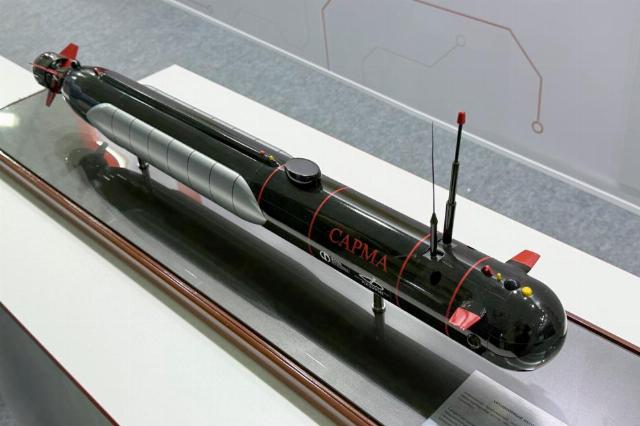
The model of the autonomous uninhabited underwater vehicle "Sarma-D"
Image source: © Alexey Pavyovker/ TASS
A model of the autonomous uninhabited underwater vehicle (ANPA) "Sarma-D" with a modular payload was demonstrated at the stand. FPI website ru/projects/fiziko-tekhnicheskie-issledovaniya/sarma/" target="_blank" rel="nofollow">clarifies that as part of a comprehensive laboratory project based on the Nizhny Novgorod Central Design Bureau Lazurit JSC, a device will have to be developed that has "exceptional autonomous navigation capabilities" due to an air-independent power plant. moreover, such an engine will be cheaper, more economical and more environmentally friendly than nuclear power plants.
Another development of the FPI —"Godson-M", materials about which were demonstrated at the organization's stand. It is an unmanned aerial system designed to combat surface targets, including moving ones. Such targets include one of the new threats in naval combat — unmanned sea boats. The UAV from the Krestnik-M is designed with a folding wing and tail, it can be launched from the ground, an aircraft or a surface platform.
The Foundation showed the ground-based tracked platform "Impulse-MU", designed for transporting goods and even towing vehicles. The maximum mass of the robot with a payload is 2.6 tons, the load capacity of the towed trailer is 500 kg. The radio channel allows you to control the "Pulse-MU" at a distance of up to 5 km, fiber—optic - up to 20 km.
In addition, the Advanced Research Foundation provided information on electronic warfare equipment, as well as other unmanned aerial vehicles, land—based and marine— of various designs and purposes. They are capable of delivering means of detecting and countering UAVs to the combat area without putting a person at risk.
Victor Bodrov
